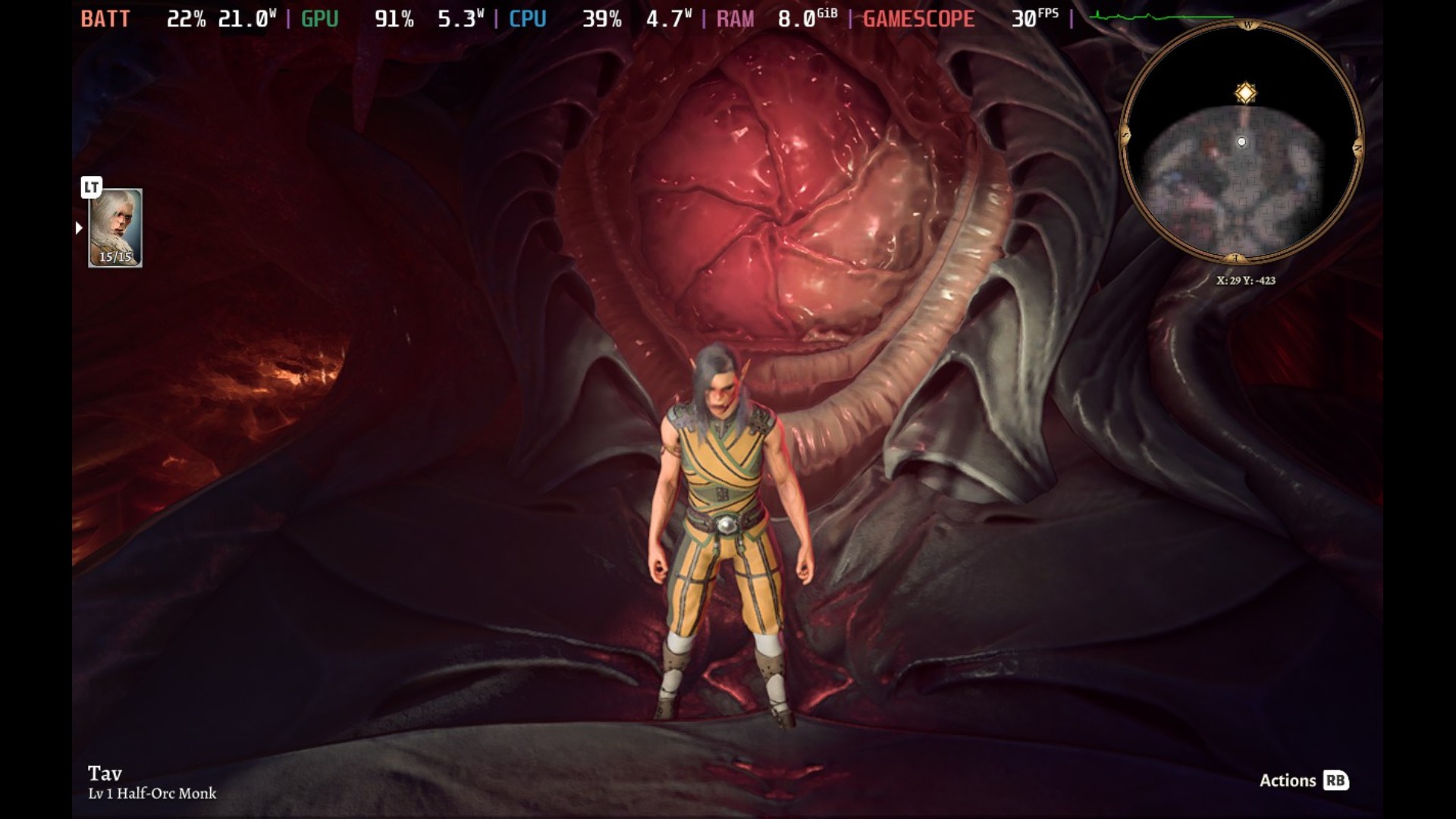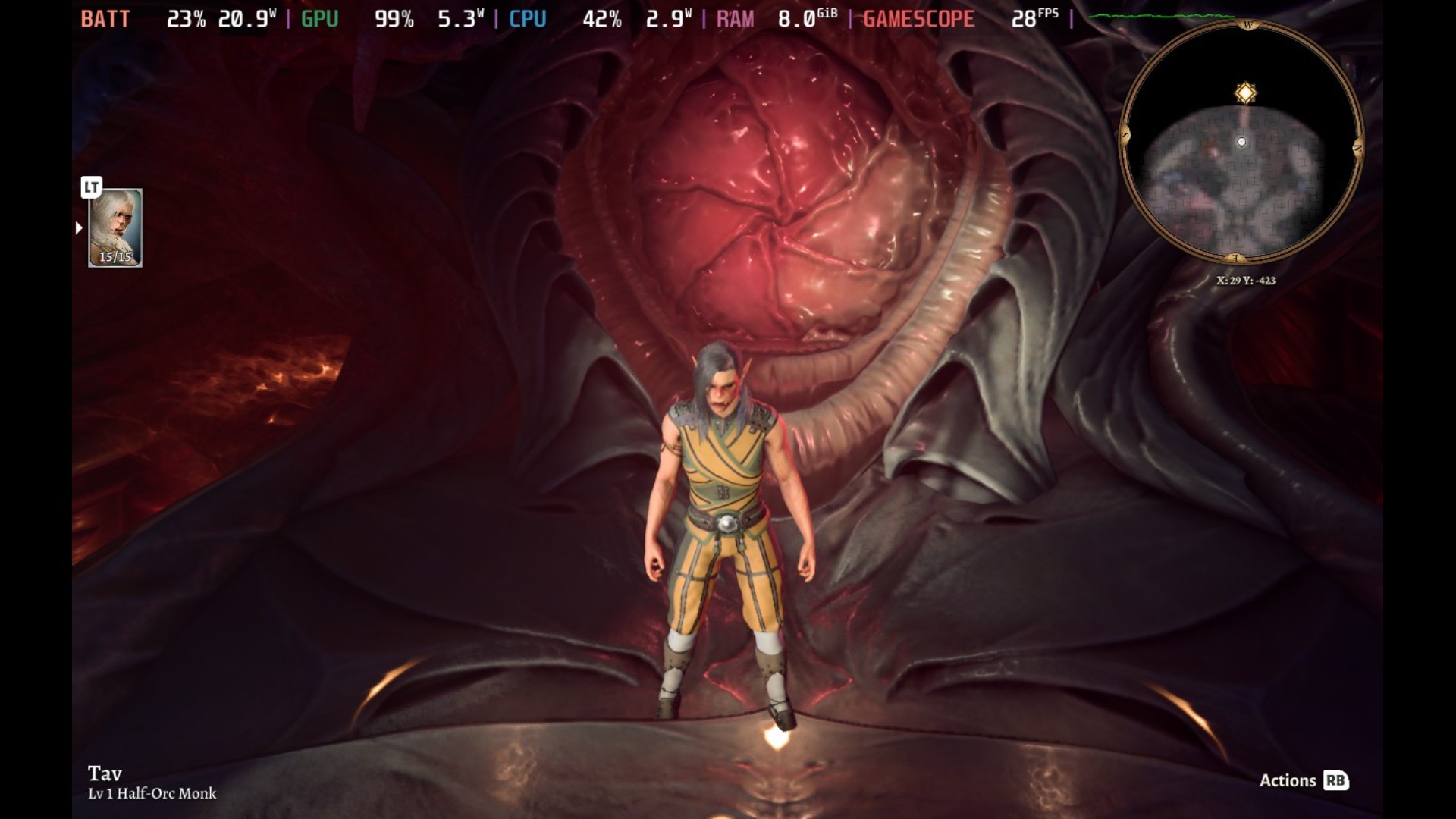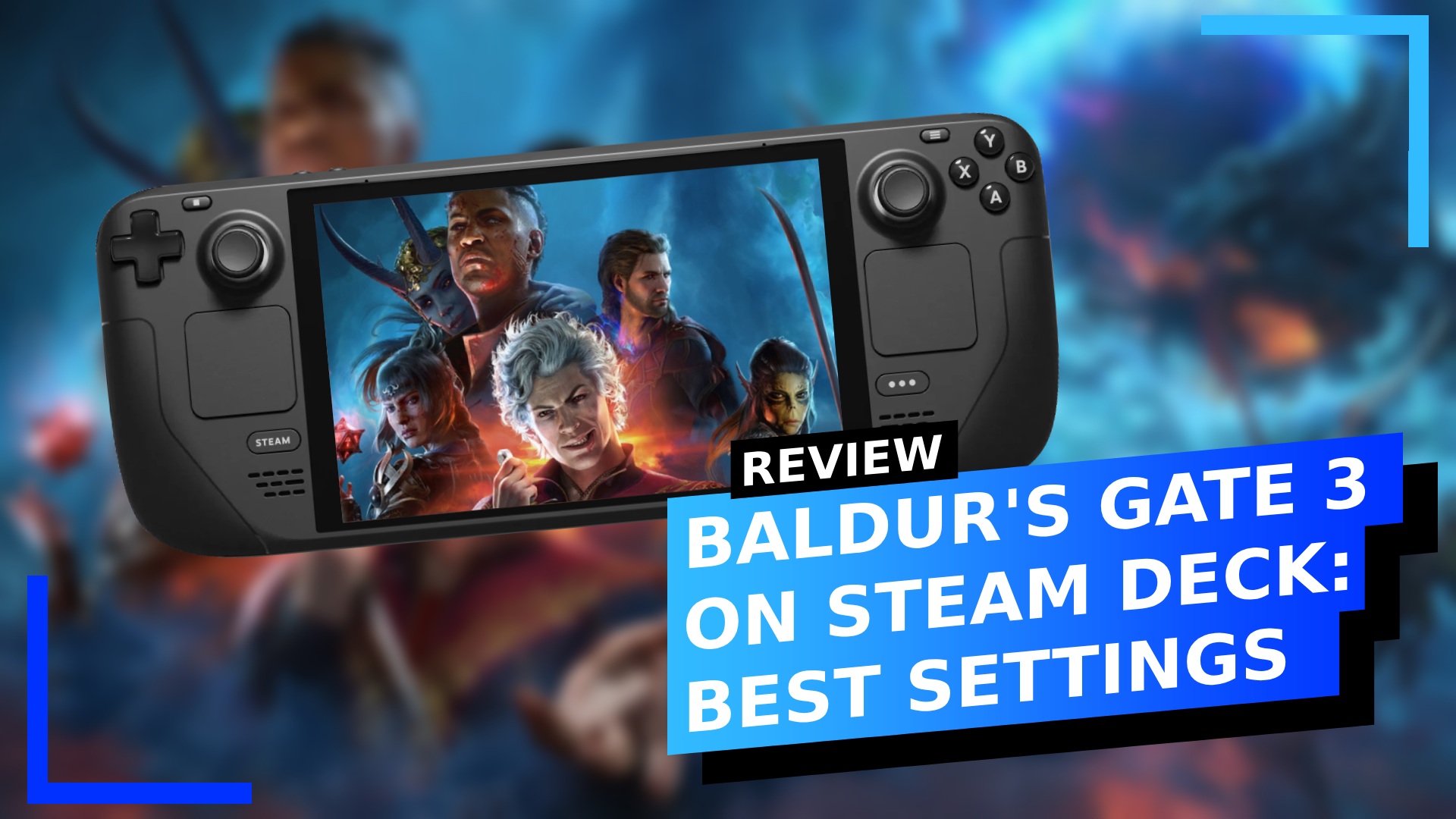Baldur’s Gate 3 is listed as verified by Valve, which means it’s considered playable from start to finish with legible text and minimal issues. From my own experience of playing Baldur’s Gate 3 on the Steam Deck, that’s an accurate assessment, but you need to go into it with your expectations in check.
Baldur’s Gate 3 Steam Deck Performance.
Baldur’s Gate 3 is somewhat of a quagmire when it comes to performance. 60 frames per second isn’t possible, and in docked mode 1080p is out of the question. But, during the 30-plus hours of playtime I’ve racked up so far, the vast majority of the time will be spent around the 30 frames-per-second mark.
The range here is roughly 27 to 34 frames for battles and exploration, while cutscenes can reach into the high 30s, low 40s.
On paper this all sounds pretty dire, but developer Larian Studios has crafted something that feels fluid at lower framerates. I’ve been playing Baldur’s Gate 3 on the Steam Deck, the ROG Ally, and the ROG Ally with my 4090 XG Mobile hooked up, and while the difference in visuals is instantly clear, I don’t feel like I’m missing anything substantial when switching from 60 frames on the XG Mobile down to 27 on the Steam Deck. That’s how fluid this game is.
And don’t get me wrong, I’m a framerate snob. I want everything to be 60 frames per second. But Baldur’s Gate 3 has been designed in such a way that it works exceptionally well even at lower framerates. In terms of tech, it’s the most impressive showcase I’ve seen this year. I am baffled by how Larian managed to pull this off!
Recommended Settings for Fluid Gameplay.


To achieve a fluid framerate you are going to need to sacrifice some of the visual quality. Not much, though. The game will still look and feel great.
These settings have been designed for an entire playthrough. I won’t spoil anything, but certain areas in Act 2 and Act 3 provide a little more lag than the opening area, so I’ve designed these settings with those lag spikes in mind. You’ll still feel them, but they’ll be much more manageable due to select settings being toggled to on or off.
As for the framerate, expect drops and random boosts, but for the most part, 27 to 32 is the average amount you’ll be playing with.
If you want to make the experience even more fluid, you can use the Steam Deck’s quick access menu (the “…” button) to limit the framerate to 30. You’ll still have the occasional drop below that, but the rest of the game won’t ever go higher than 30, making it feel smoother. I prefer to get the extra frames where I can get them, but if the constant jumping is an issue – especially for those who suffer from motion sickness – locking the frames to 30 is sure to help.
It’s also worth discussing AMD FSR. By default Baldur’s Gate 3 uses FSR 1.0. At launch, turning this off resulted in cleaner, sharper visuals. But since a handful of updates have been released this difference isn’t as noticeable, so I recommend setting FSR to ultra quality. This keeps the visuals in check and raises the framerate by three to four frames, which may not sound like much but is a big difference in-game.
Note: Larian has said FSR 2.0 will be coming around September 6, and this could potentially make performance even better than it already is.
| Baldur’s Gate 3 (In-game Settings) | |
| Aspect Ratio | 16:10 |
| Resolution | 1280×800 |
| Display Mode | Borderless Window |
| Vsync | Double Buffering |
| Frame Rate Cap | On |
| Maximum Frame Rate | 30 or 60 |
| General | |
| Model Quality | Medium |
| Detail Distance | Low |
| Instance Distance | Low |
| Texture Quality | Low |
| Texture Filtering | Anisotropic x2 |
| Animation Level of Detail | Low |
| Slow HDD Mode | Off |
| Dynamic Crowds | Off |
| Lighting | |
| Shadow Quality | Low |
| Cloud Quality | Low |
| Fog Quality | Low |
| Post Process | |
| AMD FSR 1.0 | Ultra Quality |
| Fidelity FX Sharpening | Off |
| Anti-Aliasing | SMAA |
| Ambient Occlusion | On |
| Depth of Field | None |
| God Rays | Off |
| Bloom | Off |
| Subsurface Scattering | Off |
| Steam Deck Settings (Quick Access Menu) | |
| TDP: 12 | Estimated Battery Life: 1 Hour 30 minutes |
| Docked Mode Resolution: 1280x720 | FSR: On (Docked Mode) |
| GPU Usage: 97% | Temperature: 74 degrees |
| Battery Drain: 22w | FPS: 30 or 60 |
| Extra Info | |
| Fills the Entire Steam Deck Screen | Yes |
| Valve Grading | Verified |
| Performance Rating: 3/5 | |
Bugs and Issues.
Baldur’s Gate 3 isn’t a buggy game, but there are a handful of issues that did pop up during my time with the game.
These included characters forming a T-pose and sliding across the floor, the wrong character camera angle in cutscenes, and a handful of floating items.
All in all, it’s nothing major, and most problems can be fixed by reloading a save or continuing forward in the story.
Verdict.
It’s safe to assume Baldur’s Gate 3 has serious game of the year potential. There is currently nothing else like it on the market. If you want a game where you make choices that hang over you like a black cloud, you’re going to love Baldur’s Gate 3.
On Steam Deck, performance is a simple question to answer: The game has been designed with the Steam Deck in mind, and performance is solid despite the lower framerates. The controller implementation does take some time to adapt to (there are LOADS of different commands at the player’s disposal), but when Baldur’s Gate 3 clicks, it clicks.
Should you play Baldur’s Gate 3 on the Steam Deck? That’s gotta be a resounding yes.

Disclosure: Review code provided by PR. | To learn more about our review policy click here. | Alternatively, click here to find out why you can trust me.
How I Tested.
At the time of writing, I logged 32.6 hours playing Baldur’s Gate 3. A review code was provided by Sandbox Strategies. All screenshots shown in this review were captured on Steam Deck hardware.
Testing involved running the game with different settings on the Steam Deck, the ROG Ally, and the ROG Ally with the 4090 XG Mobile attached. This allowed me to get a reading on how the game performs across a range of different devices, each with different levels of power.
I then went back to the Steam Deck with a clear picture of how the game runs and started tweaking the settings. Once I found something that gave promising results, I then played for 20 minutes to see how it faired before once again tweaking the settings to try something new. Once I found a winning combination, I played through the game to see how they handled over the course of my main playthrough.
The end result of my testing is the settings you’ll find above. If you have any questions or concerns, feel free to use the contact page and I’ll try to reply ASAP.

